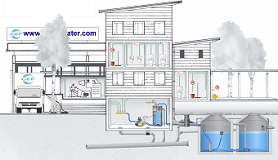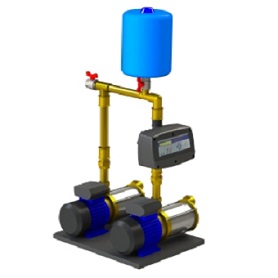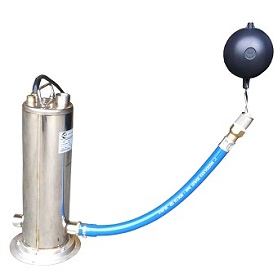Rainwater pumps
-
IRM Rainwaterpumps

Rainwatersystem Residential construction
A suitable rainwater system for every home. For homes, the filtered rainwater can be used for toilet flushing, washing machine and garden. This means that savings of more than 50% can be realized. With the IRM ™ rainwater systems from GEP, when the rainwater tank is empty, the rainwater system is switched to drinking water without refilling the rainwater tank with drinking water. So there will never be drinking water in the rainwater tank! Various types of IRM ™ rainwater systems are available, with different pump capacities and different types of pumps. See our pumps here. There is the very energy-efficient IRM-1, or the IRM-S that the pump has in the rainwater well. There are many different rainwater systems available with the IRM ™ range. An IRM ™ rainwater system can be combined with all rainwater tanks and rainwater tanks from GEP. You can also create a design of a rainwater system online via the online GEP rainwater calculation module.
Read more
Rainwatersystem Industrial construction
For relatively large projects within utility and industrial construction, different requirements and conditions apply to housing construction. GEP has developed special systems for such large projects; the so-called IRM ™ hybrid systems. With the hybrid rainwater system, rainwater is first pumped from the large tank to the system tank. From this system tank a pressure boost provides the tap points of water. There are also self-priming systems available, mostly equipped with double rainwater pumps, these should be relatively close to the rainwater well. You can also create a design of a rainwater system online via the online GEP rainwater calculation module.
Read more -
Self-priming Rainwaterpumps

Self-priming rainwaterpumps for Residential construction
The use of rainwater is done in the simplest way with a self-priming rainwater pump that is installed indoors. Rainwater pumps suck rainwater from the rain citern and pump it to the desired drain points. The GEP inner pumps are available in different capacities. The self-priming rainwater pumps must always be used in combination with a non-return valve in the suction line, preferably with a floating suction type of GEP.
Read more
Self-priming pumps for Industrial construction
The double or triple centrifugal pumps from GEP are made up of 2 or 3 self-priming pumps that are controlled by a central control system. These pump systems can be used in utility projects where large peak loads can arise, such as schools, catering establishments and cultural institutions. GEP has a wide range of such rainwater pumps, with different capacities and pressures.
Read more -
Submersible pumps for rainwater
Residential construction
What are submersible pumps? Submersible pumps are pumps which are submerged in the rainwater which is then pumped back. Since submersible pumps move underneath the collected rainwater, submersible pumps can pump the rainwater to the correct height. On the other hand, the power and permissible pressure of a submersible pump must be taken into account, there are many different submersible pumps. Submersible pumps pump the collected rainwater from the storage back to the tapping points where the rainwater can be reused. Examples of these tapping points can be: toilet flushing, garden watering or your washing machine. Residental construction Submersible pumps are especially suitable for homes where there is little space in the home for an inner pump. Even when noise is expected from a self-priming rainwater pump in the home, it is advisable to consider an underwater submersible pump. Another important reason for choosing submersible pumps is the distance between the rainwater citerns and the available space in home. If this distance is greater than 15 meters, the time should be chosen for pressurized submersible pumps.
Read more
Industrial construction
What are submersible pumps? Submersible pumps are pumps which are submerged in the rainwater which is then pumped back. Since submersible pumps move underneath the collected rainwater, submersible pumps can pump the rainwater to the correct height. On the other hand, the power and permissible pressure of a submersible pump must be taken into account, there are many different submersible pumps. Submersible pumps pump the collected rainwater from the storage back to the tapping points where the rainwater can be reused. Examples of these tapping points can be: toilet flushing, garden watering or your washing machine. Industrial construction In industrial applications, pressure submersible pumps with a large capacity are available. GEP also has controls that can control two or three pressure immersion pumps. This makes it possible to have very large pump capacities, from small offices to large halls, for each project GEP has a suitable rainwater pump. Rainwater for everyone!
Read moreGarden submersible pump
Complete pump system with integrated electronics for underwater setups in rainwater reuse systems. This pump system is ideal for rainwater systems in the garden, so a rainwater tank with built-in rainwater pump. The integrated rainwater pump control system automatically controls the on/off of the rainwater pump on the basis of the fact that a tap is opened or closed by the user. The pump control also protects the pump against dry running. The GEP Divepress submersible pump, a hydrophor of the submersible pump type, is therefore installed invisibly and silently at the bottom of the rainwater citern. The control with dry run protection is built into the pump, so not loose like most rainwater pumps. The pump can be supplied with 2 types of suction systems. The solid suction has the advantage that as soon as the water level rises again, it automatically fills up again, whereupon the risk of overheating becomes zero. The suction hose has the advantage to always suck the cleanest water out of the citern, about 10 cm below the water surface in the rainwater tank. - The pump starts automatically when a tapping point is opened and stops when the tapping point is closed. - Equipped with internal capacitor, double mechanical seal and thermal protection. - Equipped with a check valve and 15 meters of cable. - Full corrosion resistant materials. - Mechanical seal. - Built-in thermal protection. - Max. immersion depth 7 meters.
Read more